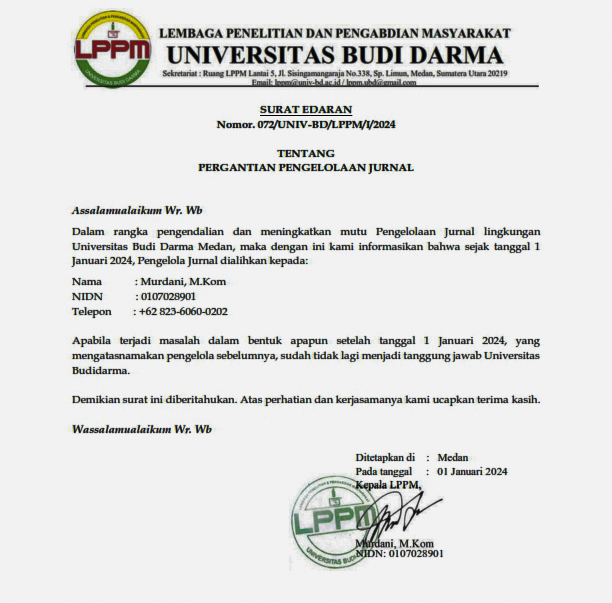Klasifikasi Sinyal EEG Untuk Mengenali Jenis Emosi Menggunakan Deep Learning
DOI:
https://doi.org/10.30865/json.v5i2.7172Keywords:
Convolutional Neural Networks (CNN), Bidirectional LSTM (Bi-LSTM), Deep Neural Network (DNN), Sinyal EEGAbstract
This research focuses on in-depth exploration and analysis of the application of three types of deep learning, namely Convolutional Neural Networks (CNN), Bidirectional LSTM (BI-LSTM) and Deep Neural Network (DNN). The three models are trained with the same parameters, consisting of three layers, using the Relu activation function, and applying 1 dropout level. In order to compare the performance of the three, experiments were carried out using three dataset groups for training and evaluation of performance. The evaluation includes metrics such as accuracy, recall, F1-Score, and areas under the curve (AUC). The dataset used is EEG Emotion which consists of 2458 unique variables. In terms of performance, BI-LSTM succeeded in outperformed the performance of CNN and DNN in the task of classification of emotional data based on EEG signals. On the other hand, CNN and DNN show excess in the acceleration of the training process compared to BI-LSTM. Although the accuracy of the two methods is almost similar in all data distribution, but in the evaluation of the ROC curve, the BI-LSTM model demonstrates superior with a more optimal curve than CNN and DNN.References
H. Donmez and N. Ozkurt, “Emotion Classification from EEG Signals in Convolutional Neural Networks,†Proc. - 2019 Innov. Intell. Syst. Appl. Conf. ASYU 2019, 2019, doi: 10.1109/ASYU48272.2019.8946364.
H. Mei and X. Xu, “EEG-based emotion classification using convolutional neural network,†in 2017 International Conference on Security, Pattern Analysis, and Cybernetics, SPAC 2017, Dec. 2018, vol. 2018-Janua, pp. 130–135, doi: 10.1109/SPAC.2017.8304263.
J. Huang, X. Xu, and T. Zhang, “Emotion classification using deep neural networks and emotional patches,†Proc. - 2017 IEEE Int. Conf. Bioinforma. Biomed. BIBM 2017, vol. 2017-Janua, pp. 958–962, 2017, doi: 10.1109/BIBM.2017.8217786.
H. Zhang, “Expression-eeg based collaborative multimodal emotion recognition using deep autoencoder,†IEEE Access, vol. 8, pp. 164130–164143, 2020, doi: 10.1109/ACCESS.2020.3021994.
B. Yang, X. Han, and J. Tang, “Three class emotions recognition based on deep learning using staked autoencoder,†Proc. - 2017 10th Int. Congr. Image Signal Process. Biomed. Eng. Informatics, CISP-BMEI 2017, vol. 2018-Janua, pp. 1–5, 2018, doi: 10.1109/CISP-BMEI.2017.8302098.
J. J. Lasiman and D. P. Lestari, “Speech Emotion Recognition for Indonesian Language Using Long Short-Term Memory,†2018 Int. Conf. Comput. Control. Informatics its Appl. Recent Challenges Mach. Learn. Comput. Appl. IC3INA 2018 - Proceeding, pp. 40–43, 2019, doi: 10.1109/IC3INA.2018.8629525.
J. R. Zhuang, Y. J. Guan, H. Nagayoshi, K. Muramatsu, K. Watanuki, and E. Tanaka, “Real-time emotion recognition system with multiple physiological signals,†J. Adv. Mech. Des. Syst. Manuf., vol. 13, no. 4, pp. 1–16, 2019, doi: 10.1299/jamdsm.2019jamdsm0075.
K. Nalbant, B. M. Kalaycı, D. Akdemir, S. Akgül, and N. Kanbur, “Emotion regulation, emotion recognition, and empathy in adolescents with anorexia nervosa,†Eat. Weight Disord., vol. 24, no. 5, pp. 825–834, 2019, doi: 10.1007/s40519-019-00768-8.
L. N. Rani, “Klasifikasi Nasabah Menggunakan Algoritma C4 . 5 Sebagai Dasar Pemberian Kredit,†2016.
I. Saputra and D. A. Kristiyanti, “Machine learning untuk pemula,†in Penerbit INFORMATIKA, Penerbit INFORMATIKA, 2022.
D. Maheshwari, S. K. Ghosh, R. K. Tripathy, M. Sharma, and U. R. Acharya, “Automated accurate emotion recognition system using rhythm-specific deep convolutional neural network technique with multi-channel EEG signals,†Comput. Biol. Med., vol. 134, no. April, p. 104428, 2021, doi: 10.1016/j.compbiomed.2021.104428.
M. R. Islam et al., “EEG Channel Correlation Based Model for Emotion Recognition,†Comput. Biol. Med., vol. 136, no. August, p. 104757, 2021, doi: 10.1016/j.compbiomed.2021.104757.
P. Wu, X. Li, S. Shen, and D. He, “Social media opinion summarization using emotion cognition and convolutional neural networks,†Int. J. Inf. Manage., vol. 51, no. December 2018, p. 101978, 2020, doi: 10.1016/j.ijinfomgt.2019.07.004.
Arjun, A. S. Rajpoot, and M. R. Panicker, “Subject independent emotion recognition using EEG signals employing attention driven neural networks,†Biomed. Signal Process. Control, vol. 75, no. February, p. 103547, 2022, doi: 10.1016/j.bspc.2022.103547.
L. Sun, B. Zou, S. Fu, J. Chen, and F. Wang, “Speech emotion recognition based on DNN-decision tree SVM model,†Speech Commun., vol. 115, no. October, pp. 29–37, 2019, doi: 10.1016/j.specom.2019.10.004.
S. Hizlisoy, S. Yildirim, and Z. Tufekci, “Music emotion recognition using convolutional long short term memory deep neural networks,†Eng. Sci. Technol. an Int. J., vol. 24, no. 3, pp. 760–767, 2021, doi: 10.1016/j.jestch.2020.10.009.
B. Jang, M. Kim, G. Harerimana, S. U. Kang, and J. W. Kim, “Bi-LSTM model to increase accuracy in text classification: Combining word2vec CNN and attention mechanism,†Appl. Sci., vol. 10, no. 17, 2020, doi: 10.3390/app10175841.
X. Hu, S. Yuan, F. Xu, Y. Leng, K. Yuan, and Q. Yuan, “Scalp EEG classification using deep Bi-LSTM network for seizure detection,†Comput. Biol. Med., vol. 124, no. June, p. 103919, 2020, doi: 10.1016/j.compbiomed.2020.103919.
I. Mehmood et al., “Deep learning-based construction equipment operators’ mental fatigue classification using wearable EEG sensor data,†Adv. Eng. Informatics, vol. 56, no. April, p. 101978, 2023, doi: 10.1016/j.aei.2023.101978.
I. Ariza, L. J. Tardón, A. M. Barbancho, I. De-Torres, and I. Barbancho, “Bi-LSTM neural network for EEG-based error detection in musicians’ performance,†Biomed. Signal Process. Control, vol. 78, no. May, p. 103885, 2022, doi: 10.1016/j.bspc.2022.103885.
J. J. Bird, A. Ekart, and D. R. Faria, “Mental Emotional Sentiment Classification with an EEG-based Brain-machine Interface HANDLE Project (EU FP7) View project EMG-controlled 3D Printed Prosthetic Hand for Academia View project,†no. January, 2019, [Online]. Available: http://dx.doi.org/10.17501
Downloads
Published
How to Cite
Issue
Section
License

This work is licensed under a Creative Commons Attribution 4.0 International License
Authors who publish with this journal agree to the following terms:
- Authors retain copyright and grant the journal right of first publication with the work simultaneously licensed under Creative Commons Attribution 4.0 International License that allows others to share the work with an acknowledgment of the work's authorship and initial publication in this journal.
- Authors are able to enter into separate, additional contractual arrangements for the non-exclusive distribution of the journal's published version of the work (e.g., post it to an institutional repository or publish it in a book), with an acknowledgment of its initial publication in this journal.
- Authors are permitted and encouraged to post their work online (e.g., in institutional repositories or on their website) prior to and during the submission process, as it can lead to productive exchanges, as well as earlier and greater citation of published work (Refer to The Effect of Open Access).





